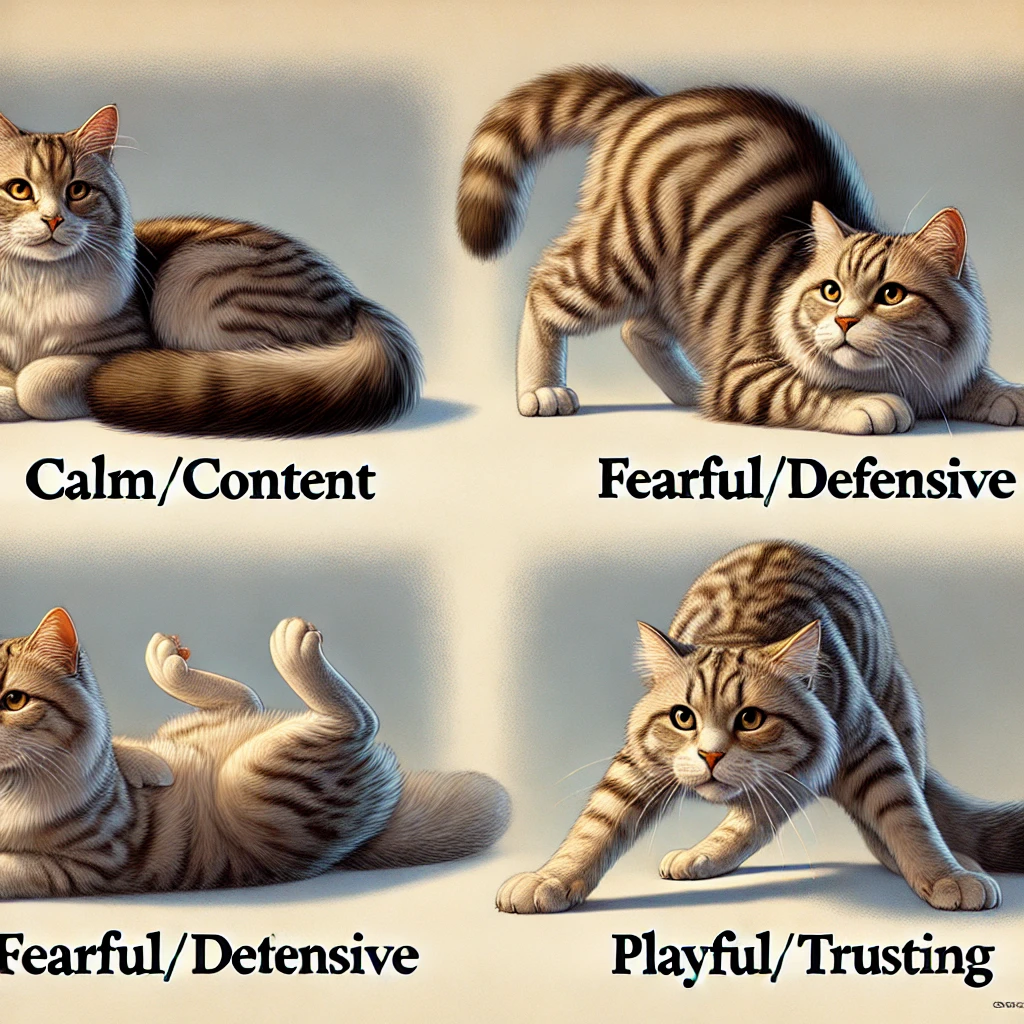Unlock the secrets of your cat’s emotions by understanding their cat body language.
Introduction
Have you ever wondered what your cat is trying to tell you through their movements and postures? Cat body language is a subtle yet powerful way cats communicate their feelings—from contentment to aggression. By learning to interpret your cat’s body language, you can better understand their emotions and respond appropriately. In this article, we’ll explore the significance of overall body posture and decode some common stances.
Recognizing Relaxed Postures vs. Defensive Stances
Relaxed Postures
A relaxed cat is a happy cat. Recognizing these signs in your cat’s body language indicates they are feeling calm and content:
- Loose Muscles: The cat’s body appears soft, with no tension in the muscles.
- Comfortable Positions: They may lie on their side, belly up, paws tucked under, or stretched out.
- Ears Forward: Ears are facing forward, indicating interest and comfort.
- Slow Blinking: Gentle eye movements suggest relaxation.
- Tail Behavior: The tail is still or moving slowly in gentle sways.
When your cat is in this state, it’s a great time to engage in gentle petting or simply enjoy their peaceful company.
Defensive Stances
A defensive posture in cat body language indicates that your cat feels threatened or uneasy. Recognizing these signs can help you avoid escalating the situation:
- Tense Muscles: The body is stiff, and muscles are contracted.
- Ears Flattened: Ears are pinned back against the head.
- Dilated Pupils: Eyes may appear wide with large pupils.
- Whiskers Back: Whiskers are pulled back against the face.
- Tail Position: The tail may be tucked close to the body or flicking rapidly.
If you notice these signs, it’s best to give your cat some space and identify any potential stressors in their environment.
Learn more about recognizing stress in cats
The Meanings Behind Arched Backs and Puffed Fur
Arched Back
An arched back can have different meanings in cat body language, depending on the context.
Fear or Aggression
- Puffed Fur: When combined with puffed-up fur, an arched back is a classic sign of fear or defensive aggression.
- Sideways Stance: The cat may stand sideways to appear larger to a perceived threat.
- Hissing or Growling: Vocalizations often accompany this posture.
In this situation, your cat is trying to protect themselves. It’s important not to approach or provoke them further.
Stretching
- Relaxed Fur: If the fur is not puffed up and the cat is stretching after a nap, the arched back indicates relaxation and comfort.
- Slow Movements: Movements are slow and deliberate, not sudden or jerky.
Puffed Fur (Piloerection)
Puffed-up fur occurs when the hair stands on end, making the cat appear larger.
- Fear Response: This is a natural reaction to threats, helping the cat look more intimidating.
- Cold Temperatures: Sometimes, cats puff their fur to retain heat in chilly environments.
- Excitement: Rarely, puffed fur can indicate high excitement during intense play.
Understanding the context is key to interpreting why your cat’s fur is puffed up.
Explore more about cat aggression
How Crouching Indicates Readiness or Fear
Crouching in Preparation
A crouching cat may be getting ready to pounce:
- Playful Stalking: In play, a crouch precedes a playful pounce on a toy or another pet.
- Focused Eyes: Eyes are focused intently on the target.
- Tail Twitching: The tail may twitch slightly as the cat prepares to leap.
This is a normal and healthy behavior that allows your cat to exercise their natural hunting instincts.
Crouching in Fear
Alternatively, crouching can be a sign of fear or submission:
- Body Low to the Ground: The cat tries to make themselves appear smaller.
- Ears Back: Ears may be flattened against the head.
- Avoiding Eye Contact: The cat may look away or keep their eyes wide and vigilant.
- Quiet and Still: They may remain very still to avoid detection.
In this case, it’s important to create a safe environment and avoid making sudden movements.
Understanding feline fear and anxiety
Understanding Rolling Over and Its Implications
Trust and Contentment
When a cat rolls onto their back and exposes their belly, it often signifies trust:
- Vulnerability: The belly is a vulnerable area; showing it means your cat feels safe.
- Invitation to Play: Sometimes, it’s an invitation for gentle play.
- Relaxed Posture: The cat appears loose and comfortable.
While it’s tempting to give a belly rub, many cats prefer not to be touched there. Observe their reaction before proceeding.
Defensive Behavior
Sometimes, rolling over can be a defensive tactic:
- Defensive Posture: The cat may roll over to position themselves to use all four paws, especially if they feel cornered.
- Hissing or Growling: Vocalizations indicate they are not in a playful mood.
- Ears Back and Eyes Dilated: Signs of agitation or fear.
In such cases, it’s best to give your cat space and avoid interaction until they calm down.
Learn how to approach your cat safely
Conclusion
By understanding your cat’s body language, you can gain valuable insights into their emotions and needs. Recognizing the differences between relaxed postures and defensive stances allows you to respond appropriately, strengthening your bond with your feline friend. Remember, context is crucial—consider the overall situation and accompanying cues like tail movements, ear positions, and vocalizations. With patience and observation, you’ll become fluent in your cat’s silent language, making for a happier and more harmonious household.






